What is Offset Printing Used For?

Offset printing is a printing technique used to produce a wide variety of printed materials. It is the most widely utilized commercial printing method today and is known for its consistent and high-quality results.
Offset printing involves the transfer of an inked image from a metal plate to a rubber sheet. From there, the image is transferred to the material to be printed on.
This printing method is commonly combined with the lithographic process, which relies on oil and water repulsion. Printers use a flat image carrier to pick up ink from rollers, which adheres to the image area. The non-printing area remains free of ink by adhering to a water-based film referred to as the “fountain solution”.
Common Applications for Offset Printing
Offset printing is used in the production of many types of printed material, including:
- Newspapers
- Magazines
- Posters
- Banners
- Books
- Brochures
- Stationery
- Marketing materials
Offset printing is usually used for large print runs of 1,000 copies or more. The process is relatively inexpensive, and the cost goes down the more copies are made. This printing method also makes it possible to produce a high volume of prints at consistently high quality.
Advantages of Offset Printing
Offset printing offers many benefits over other printing techniques, including:
Consistency. Offset printing makes it possible to produce high-volume print runs with the same quality from the first print to the last. Any discrepancies between copies are usually negligible or even undetectable.
High quality. Compared to other printing methods such as letterpress printing, the images produced by offset printing are of noticeably higher quality. Lines are sharp and clean, printing colors are more vibrant, and there is considerably more detail. This quality is due to the use of a rubber blanket, which conforms closely to the printing surface’s texture.
Versatility. Offset printing accommodates a wide variety of materials and paper types. It even works on materials with custom finishes, making it possible to produce unique-looking printed products.
This versatility extends to the ink options as well. You can use almost any type of ink with offset printing. It even allows the use of Pantone colors, metallic inks, and other custom ink varieties.
Longer print plate life. Compared to direct lithographic printing, offset printing doesn’t involve placing the printing plate in direct contact with the printing surface. This prolongs the useable life of the plate. When used with the correct ink and fountain solution, properly developed plates can produce more than a million prints.
Low cost. Offset printing is the most cost-effective method for producing large volume prints of consistently high quality. Furthermore, the price per piece decreases the more copies you print.
Easy print modification. With offset printing, it is relatively easy to adjust the amount of ink applied to the print material. By controlling the amount of ink transferred onto the fountain roller, you can adjust color density as needed.
Disadvantages of Offset Printing
Offset printing does have some drawbacks compared to other printing methods. For one thing, the image quality produced isn’t quite as good as that of photogravure or rotogravure printing.
The anodized aluminum printing plates are prone to oxidation. This could result in some ink being transferred to non-image areas.
Finally, producing printing plates and setting up the press requires considerable time and money. This makes offset printing less feasible for small runs.
When to Go for Offset Printing
Should you go for offset printing or another printing method? Consider these factors to help you decide if offset printing is the best option for you:
Quantity. Offset printing is better suited for large volume printing due to the upfront cost. Although the price per piece is somewhat high with short runs, this goes down the more copies you produce.
Print medium. Offset printing supports a wide variety of printed mediums, much more so than any other printing method. If you need to print on non-standard-sized paper or special materials, offset printing is the most flexible option.
Color. Offset printing is a practical solution for printing jobs that require only one or two colors. But it is also the best choice for printing Pantone colors, which it can produce accurately due to the use of Pantone ink.
Time constraints. Offset printing requires a considerable amount of time. If you need a faster turnaround, digital printing might be the better alternative.
Proofing requirements. Color proofing can be quite costly with offset printing. Digital printing is the more cost-effective option if you need accurate printing proofs.
Offset printing isn’t the best option for all possible print scenarios. Even so, its benefits are undeniable, and it remains one of the most reliable and cost-effective ways to produce large amounts of high-quality prints.
